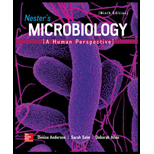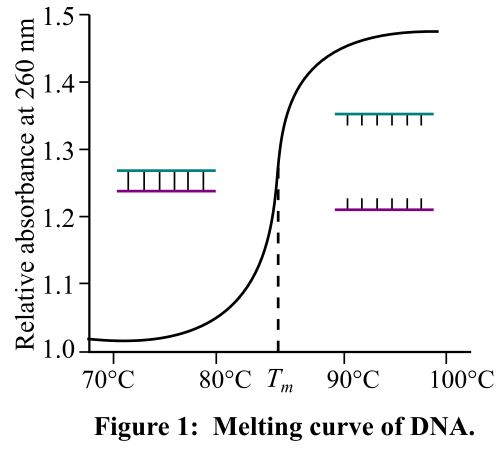
Nester's Microbiology: A Human Perspective
9th Edition
ISBN: 9781259709999
Author: Denise G. Anderson Lecturer, Sarah Salm, Deborah Allen
Publisher: McGraw-Hill Education
expand_more
expand_more
format_list_bulleted
Concept explainers
Question
Chapter 10, Problem 1CT
Summary Introduction
To review:
The variationin the curve if GC (Guanine–Cytosine) and AT (Adenine–Thymine) content is increased.
Introduction:
DNA (deoxyribonucleic acid) and RNA (Ribonucleic acid) of every individual have a particular amount of GC and AT content. GC content is the concentration of guanine-cytosine and AT content is the concentration of adenine-thymine (nitrogenous bases) in the DNA. The melting temperature increaseswith increase in GC content. The graph (figure 1) showing melting curve of DNA.

Expert Solution & Answer
Want to see the full answer?
Check out a sample textbook solution
Students have asked these similar questions
help tutor please
Q8. A researcher wants to study the effectiveness of a pill intended to reduce stomach heartburn in pregnant
women. The researcher chooses randomly 400 women to participate in this experiment for 9 months of their
pregnancy period. They all need to have the same diet. The researcher designs two groups of 200 participants:
One group take the real medication intended to reduce heartburn, while the other group take placebo
medication. In this study what are:
Independent variable:
Dependent variable:
Control variable:
Experimental group: "
Control group:
If the participants do not know who is consuming the real pills and who is consuming the sugar pills.
This study is
It happens that 40% of the participants do not find the treatment helpful and drop out after 6 months.
The researcher throws out the data from subjects that drop out. What type of bias is there in this study?
If the company who makes the medication funds this research, what type of bias might exist in this
research work?
How do I determine the inhertiance pattern from the pedigree diagram?
Chapter 10 Solutions
Nester's Microbiology: A Human Perspective
Ch. 10 - Name and describe the three areas of taxonomy.Ch. 10 -
2. Explain the basis for the three-domain systems...Ch. 10 -
3. Describe how a dichotomous key is used when...Ch. 10 - Why is MALDI-TOF MS particularly important in...Ch. 10 -
5. Describe the difference between using a probe...Ch. 10 -
6. Explain how signature sequences are used in...Ch. 10 - Describe the function of PulseNet.Ch. 10 - What is a phylogenetic tree?Ch. 10 - Prob. 9SACh. 10 - Describe how the GC content of DNA can be...
Ch. 10 - Which of the following is the newest taxonomic...Ch. 10 -
2. If an acid-fast bacterium is detected in a...Ch. 10 -
3. The “breath test” for Helicobacter pylori...Ch. 10 - The “O157:H7” of E. coli O157:H7 refers to the a)...Ch. 10 - When hydrogen peroxide is placed on a colony of an...Ch. 10 - Which of the following is best to use for...Ch. 10 - If the GC content of two organisms is 70%, the a)...Ch. 10 - If two microbial isolates have similar but...Ch. 10 - The sequence of which ribosomal genes are most...Ch. 10 - Which of the following is false? a)Tropheryma...Ch. 10 -
1. Microbiologists debate the use of biochemical...Ch. 10 - A researcher interested in investigating the...Ch. 10 - Prob. 1CTCh. 10 - When DNA probes are used to detect specific...
Knowledge Booster
Learn more about
Need a deep-dive on the concept behind this application? Look no further. Learn more about this topic, biology and related others by exploring similar questions and additional content below.Similar questions
- 22. Which of the following mutant proteins is expected to have a dominant negative effect when over- expressed in normal cells? a. mutant PI3-kinase that lacks the SH2 domain but retains the kinase function b. mutant Grb2 protein that cannot bind to RTK c. mutant RTK that lacks the extracellular domain d. mutant PDK that has the PH domain but lost the kinase function e. all of the abovearrow_forwardWhat is the label ?arrow_forwardCan you described the image? Can you explain the question as well their answer and how to get to an answer to an problem like this?arrow_forward
- Describe the principle of homeostasis.arrow_forwardExplain how the hormones of the glands listed below travel around the body to target organs and tissues : Pituitary gland Hypothalamus Thyroid Parathyroid Adrenal Pineal Pancreas(islets of langerhans) Gonads (testes and ovaries) Placentaarrow_forwardWhat are the functions of the hormones produced in the glands listed below: Pituitary gland Hypothalamus Thyroid Parathyroid Adrenal Pineal Pancreas(islets of langerhans) Gonads (testes and ovaries) Placentaarrow_forward
arrow_back_ios
SEE MORE QUESTIONS
arrow_forward_ios
Recommended textbooks for you
 Human Heredity: Principles and Issues (MindTap Co...BiologyISBN:9781305251052Author:Michael CummingsPublisher:Cengage Learning
Human Heredity: Principles and Issues (MindTap Co...BiologyISBN:9781305251052Author:Michael CummingsPublisher:Cengage Learning Principles Of Radiographic Imaging: An Art And A ...Health & NutritionISBN:9781337711067Author:Richard R. Carlton, Arlene M. Adler, Vesna BalacPublisher:Cengage Learning
Principles Of Radiographic Imaging: An Art And A ...Health & NutritionISBN:9781337711067Author:Richard R. Carlton, Arlene M. Adler, Vesna BalacPublisher:Cengage Learning- Case Studies In Health Information ManagementBiologyISBN:9781337676908Author:SCHNERINGPublisher:Cengage
 Biology: The Dynamic Science (MindTap Course List)BiologyISBN:9781305389892Author:Peter J. Russell, Paul E. Hertz, Beverly McMillanPublisher:Cengage Learning
Biology: The Dynamic Science (MindTap Course List)BiologyISBN:9781305389892Author:Peter J. Russell, Paul E. Hertz, Beverly McMillanPublisher:Cengage Learning

Human Heredity: Principles and Issues (MindTap Co...
Biology
ISBN:9781305251052
Author:Michael Cummings
Publisher:Cengage Learning

Principles Of Radiographic Imaging: An Art And A ...
Health & Nutrition
ISBN:9781337711067
Author:Richard R. Carlton, Arlene M. Adler, Vesna Balac
Publisher:Cengage Learning


Case Studies In Health Information Management
Biology
ISBN:9781337676908
Author:SCHNERING
Publisher:Cengage


Biology: The Dynamic Science (MindTap Course List)
Biology
ISBN:9781305389892
Author:Peter J. Russell, Paul E. Hertz, Beverly McMillan
Publisher:Cengage Learning